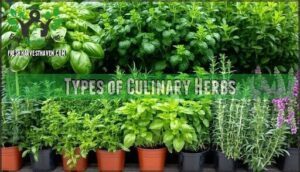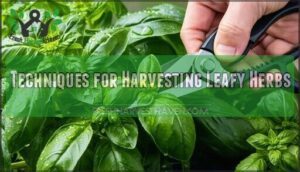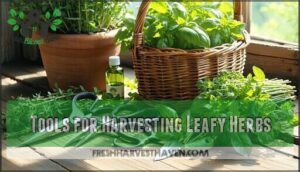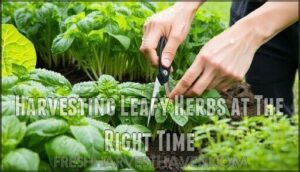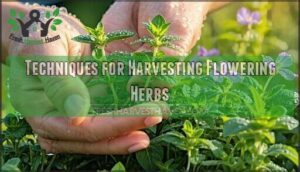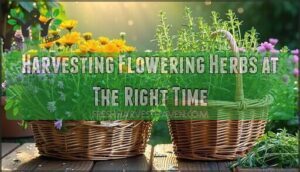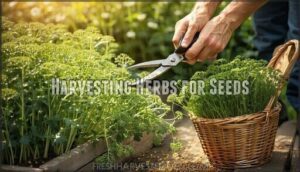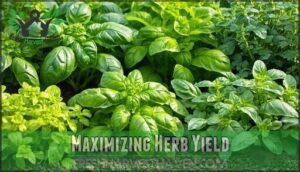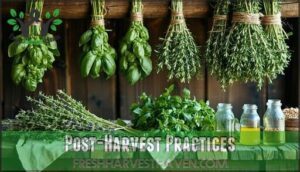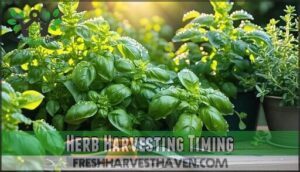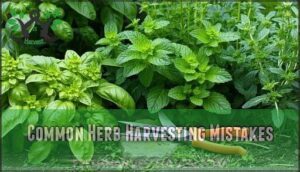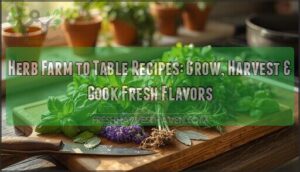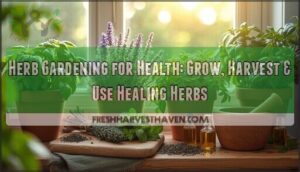This site is supported by our readers. We may earn a commission, at no cost to you, if you purchase through links.
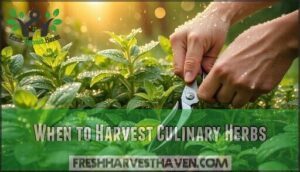 Timing is everything in the context of harvesting culinary herbs for peak flavor. You’ll want to harvest early morning after dew evaporates but before the day’s heat kicks in.
Timing is everything in the context of harvesting culinary herbs for peak flavor. You’ll want to harvest early morning after dew evaporates but before the day’s heat kicks in.
This timing captures herbs when their essential oils are most concentrated. For leafy herbs like basil and parsley, harvest before they flower – once blooms appear, leaf production drops and flavor diminishes.
However, if you’re after herb flowers, grab them just as buds form but before they fully open. This sweet spot delivers maximum oil concentration and intense flavor.
Seeds need the opposite approach – wait until they’re fully mature and dry. The secret lies in understanding each herb’s unique harvesting window to discover flavors you never knew existed.
Table Of Contents
- Key Takeaways
- Harvesting Culinary Herbs
- When to Harvest Culinary Herbs
- Types of Culinary Herbs
- Harvesting Herbs for Leaves
- Harvesting Herbs for Flowers
- Harvesting Herbs for Seeds
- Maximizing Herb Yield
- Post-Harvest Practices
- Herb Harvesting Timing
- Common Herb Harvesting Mistakes
- Frequently Asked Questions (FAQs)
- When should you harvest your herbs?
- Can culinary herbs be harvested?
- How do you care for herbs before harvesting?
- When should you pick herbs?
- When should you harvest herbs for drying?
- How do you know when to harvest herbs?
- How do I know when my herbs are ready to be picked?
- How do you know when to cut your herbs?
- Are my herbs still good if they flower?
- When to harvest culinary sage?
- Conclusion
Key Takeaways
- Harvest in early morning after dew dries but before midday heat – you’ll capture herbs when their essential oils are most concentrated for peak flavor
- Pick leafy herbs just before they flower – once blooms appear, leaf production drops and flavor diminishes significantly
- Never harvest more than one-third of your plant at once – you’ll keep plants healthy and productive for continuous harvests throughout the season
- Use sharp, clean tools and proper timing for each herb type – you’ll get clean cuts that promote regrowth while maximizing flavor concentration in leaves, flowers, or seeds
Harvesting Culinary Herbs
You’ll get the best flavors from your culinary herbs when you harvest them at the right time and use proper techniques.
Timing depends on whether you’re after leaves, flowers, or seeds, with each part having its own ideal harvest window for maximum taste and potency.
Unique Herbs for Specific Cuisines
Exploring Regional Herb Variations opens doors to authentic Global Herb Cultivation techniques.
Thai basil delivers anise-like notes perfect for stir-fries, while Mexican oregano provides citrusy robustness stronger than Mediterranean varieties.
Italian nepitella blends mint and oregano flavors, ideal for Tuscan dishes.
Understanding Uncommon Culinary Herbs like Indian fenugreek or Middle Eastern za’atar creates exceptional Cuisine-Specific Blends.
Perfect Herb-Dish Pairings depend on ideal harvest time – when culinary herbs reach peak herb flavor through proper herb harvesting techniques.
Herbs like cilantro and oregano are essential to authentic Mexican dishes, enhancing flavor complexity.
Herb Cultivation and Growing Techniques
Your culinary herbs need well-draining soil requirements and six hours of daily sunlight needs to thrive.
Establish consistent watering practices by checking soil moisture weekly.
Use companion planting for natural pest control and master propagation methods like stem cuttings to expand your garden.
These herb cultivation basics directly impact harvest time and herb flavor.
When you nail the growing fundamentals, your culinary herbs reward you with peak herb harvesting potential.
When to Harvest Culinary Herbs

Mastering herb harvesting timing transforms your culinary creations from ordinary to extraordinary.
Peak Flavor Time occurs just before flowering when essential oils concentrate in leaves.
Catch your herbs just before they bloom—that’s when flavor peaks and essential oils hit their sweet spot.
Morning vs Afternoon matters—harvest after dew dries but before midday heat dissipates aromatic compounds.
Seasonal Herb Growth patterns guide your schedule: spring and early summer offer the most vigorous flavors.
For Perennial Herb Care, stop major harvesting one month before frost to prevent tender regrowth.
The Ideal Harvest Stage varies by herb type—leafy herbs peak pre-bloom while flowering varieties shine when buds just open, during the Peak Flavor Time, with consideration for Seasonal Herb Growth.
Types of Culinary Herbs
Understanding the different types of culinary herbs helps you choose the right harvesting approach for each variety in your garden.
You’ll find three main categories: leafy herbs like basil and parsley that you harvest for their flavorful leaves, woody herbs like rosemary and thyme with sturdy stems, and flowering herbs like chives and sorrel that offer both leaves and edible blooms.
Leafy Herbs Like Basil and Parsley
Leafy herbs like basil and parsley pack incredible flavor when harvested correctly.
You’ll get maximum leaf size and flavor intensity by picking basil at 6-8 inches tall with four leaf sets. For parsley, cut outer stems at the base for continuous growth.
- Morning magic: Harvest frequency increases when you pick after dew dries – essential oils peak then
- Fresh equals best: Post-harvest washing right before use prevents decay during storage
- Smart storage: Keep basil stems in water; wrap parsley in damp towels before refrigerating
These harvesting techniques guarantee your culinary herbs deliver maximum taste. Storage methods matter just as much as timing for maintaining that garden-fresh flavor you’re after.
Woody Herbs Like Rosemary and Thyme
Why do woody herbs like rosemary and thyme deserve special attention during herb harvesting? These Mediterranean powerhouses require different techniques than their delicate leafy cousins.
Stem Tip Harvest works best for woody herbs. Use sharp pruning shears to cut 2-3 inch sprigs from branch tips, facilitating clean cuts that promote healthy regrowth. Avoiding Woody Cuts is vital—never cut into the thick, brown stems of mature rosemary plants, as they won’t regenerate.
Wait until thyme reaches Optimal Height of six inches before your first harvest. For rosemary, trim lightly and frequently rather than taking large amounts at once. This approach maintains Flavor Concentration while supporting plant health.
Regrowth Strategies focus on encouraging new tender growth. Regular light pruning prevents these herbs from becoming leggy and maintains their bushy appearance. Morning harvesting captures peak essential oil content, maximizing flavor in your culinary creations.
These harvesting techniques guarantee your woody herbs thrive season after season.
Flowering Herbs Like Chives and Sorrel
Two key flowering herbs offer unique culinary opportunities. Chive blossoms deliver mild onion flavor perfect for edible flower uses like chive blossom vinegar or salad garnishes. Sorrel flowers provide tangy notes ideal for sorrel soup recipe preparations.
Harvest blooms when they first open for peak herb flavor. Watch for flowering herb pests during this stage. Regular trimming prevents excessive herb flowering while maintaining productivity.
These flowering herbs attract beneficial insects through pollinator attraction, supporting garden health. Herb harvesting timing matters—morning collection after dew dries guarantees maximum essential oils. Both herbs reward consistent cutting with continuous bloom production throughout the growing season, making them valuable culinary herbs for fresh preparations.
Harvesting Herbs for Leaves
Harvesting leafy herbs at the right time transforms ordinary cooking into extraordinary flavors that’ll make your taste buds sing.
You’ll want to catch these green treasures just before they flower, when their essential oils are most concentrated and ready to elevate your culinary creations.
Techniques for Harvesting Leafy Herbs
Harvesting leafy herbs correctly preserves their peak flavor and promotes continued growth.
Use sharp, clean scissors or pruning shears to make precise cuts above leaf nodes for basil and mint. This pinching technique encourages bushier growth. For parsley and cilantro, cut stems at the base.
Harvest only healthy leaves, avoiding damaged or diseased foliage.
- Fresh basil leaves glistening with morning dew, their vibrant green color signaling peak essential oil content
- Clean garden shears making a crisp cut just above a node, leaving the plant ready for its next flush of growth
Tips: Use sharp, clean tools.
Reminder: Avoid overharvesting to keep plants productive longer.
Tools for Harvesting Leafy Herbs
Essential herb harvesting tools make all the difference between damaged stems and healthy regrowth. Sharp shears and herb scissors are your foundation—dull blades crush delicate tissues and invite disease.
For precise work, herb snips excel at selective picking without disturbing neighboring growth. Pruning knives handle tougher stems that scissors can’t manage, while specialized herb shears with multiple blades speed up bulk harvesting.
Tool sterilization between plants prevents bacterial spread—a quick wipe with rubbing alcohol does the trick. Your harvesting basket should breathe. Choose open-weave designs that allow air circulation, preventing moisture buildup that leads to wilting.
Avoid plastic bags that trap humidity. Keep tools clean and sharp for herb harvesting success. Well-maintained equipment protects plant health and guarantees clean cuts that heal quickly, promoting vigorous regrowth throughout the growing season.
Some gardeners find scissors work well for harvesting thicker stems.
Harvesting Leafy Herbs at The Right Time
Timing makes all the difference when harvesting basil, parsley, and other leafy culinary herbs.
Morning Harvest delivers peak essential oils concentration after dew evaporates but before afternoon heat diminishes flavor compounds. Target the Growth Stage just before flower buds appear—this Pre-Flowering Flavor phase maximizes taste intensity.
Follow these timing essentials for maximal Leafy Regrowth:
- Harvest when plants reach 4-6 inches tall with established stems
- Cut stems above leaf nodes to promote bushier growth
- Choose cool morning hours when essential oils concentrate in leaves
- Monitor twice weekly during peak growing season to catch maximal timing
Regular harvesting mint and harvesting basil using proper timing guarantees continuous production throughout the growing season.
Harvesting Herbs for Flowers
Harvesting flowering herbs at the right moment captures their peak flavor and aroma for your culinary creations.
You’ll want to cut most herb flowers when they first open or are just about to bloom, as this is when their essential oils are most concentrated, which is crucial for preserving their essential oils.
Techniques for Harvesting Flowering Herbs
Perfect timing with flowering herbs makes all the difference in your kitchen adventures.
Cut flowering herbs right as buds begin opening—this bloom stage captures peak essential oils.
Herb harvesting techniques work best in morning hours after dew evaporates. Sharp, clean cuts above leaf nodes encourage bushier regrowth while maintaining optimal length for flavor impact.
Follow the one-third rule during herb flower harvesting sessions. Handle delicate blooms gently to prevent bruising.
Post-harvest handling requires immediate water placement or proper drying methods to preserve aromatic qualities.
Tools for Harvesting Flowering Herbs
Sharp flower snips deliver precision cuts without crushing delicate petals.
Clean bud trimmers prevent disease transmission between plants.
Sterilize harvesting knives with rubbing alcohol before each use.
Your herb harvesting techniques improve dramatically with proper herb tools.
Consider purchasing specialized harvesting tools for best results.
Essential equipment for successful herb harvesting:
- Flower snips – curved blades navigate tight spaces around blooms
- Bud trimmers – fine-pointed tips access individual flower heads precisely
- Seed collectors – small containers catch falling petals and pollen brushes
Harvesting Flowering Herbs at The Right Time
You’ll want to harvest flowering herbs when blooms first open for maximum flavor intensity.
Morning harvesting captures peak essential oils before heat dissipates them.
At this bloom stage, pollination impact hasn’t diminished the plant’s energy reserves yet.
Sharp, clean cuts protect future growth while preserving delicate petals.
For culinary herbs like chives and calendula, timing matters—catch them right as flowers unfurl.
Drying flowers immediately after harvest locks in vibrant color and concentrated aromatics for your kitchen creations.
This step is crucial for retaining the maximum herb flavor and ensuring the herbs have a richer taste.
Harvesting Herbs for Seeds
Harvesting herbs for their seeds opens up a world of culinary possibilities, from aromatic coriander to pungent dill seeds that pack intense flavor into your cooking.
You’ll need to wait until the seeds mature and dry naturally on the plant, then use the right timing and techniques to collect them without losing precious seeds to the wind or ground, which involves understanding the complete process.
Techniques for Harvesting Seeds
When harvesting herb seeds becomes your focus, timing and technique make all the difference.
Wait until seed heads turn brown and dry completely on the plant, then clip them carefully into paper bags to catch every precious seed.
Gently shake or brush seeds from stems into containers.
- Seed Head Clipping: Cut brown, mature seed heads directly into paper bags
- Drying Seed Heads: Allow complete drying on plants before harvest
- Separating Seed: Shake stems or brush gently to release seeds from chaff
Tools for Harvesting Seeds
The right tools make herb seed harvesting straightforward and efficient. Snips and Shears provide clean cuts when clipping mature seed heads, preventing damage that could affect seed viability. Sharp garden scissors work equally well for most seed herbs.
Paper Bags are your best friend for collecting freshly cut seed heads. Unlike plastic, they allow air circulation during initial herb seed drying while catching loose seeds that might fall during transport. Label each bag with the herb variety and harvest date.
Drying Racks speed up the herb seed maturity process indoors. Spread seed heads in single layers for maximum airflow. Once dried, Seed Separators or simple sieves help with herb seed cleaning, removing chaff and debris efficiently.
Storage Containers preserve your harvest long-term. Glass jars with tight lids work perfectly, keeping seeds dry and pest-free. Small mesh bags inside containers prevent mixing if you’re storing multiple varieties together.
With these basic tools, herb seed harvesting becomes a systematic process that yields clean, viable seeds ready for next season’s planting. Consider using specialized garden shears for superior results.
Harvesting Seeds at The Right Time
Timing herb seed harvesting correctly guarantees maximum viability and flavor. Watch for seed maturity signs like color changes from green to brown or tan. Optimal seed time arrives when pods rattle and feel papery.
To maximize flavor, consider harvesting herbs in the morning.
Follow these steps for success:
- Cut drying seed heads on calm, dry mornings
- Hang upside down in paper bags for continued drying
- Clean seeds from chaff once fully dried
- Test seed viability before storing herb seeds in airtight containers
Maximizing Herb Yield
You’ll get the most herbs from your garden when you harvest strategically and maintain your plants properly.
Regular cutting encourages new growth and prevents your herbs from going to seed, which keeps them producing fresh leaves all season long, and this is achieved through strategic harvesting.
Cut-and-Come-Again Harvesting Techniques
Master the cut-and-come-again method by snipping mature leaves above nodes while leaving younger growth untouched.
Follow the one-third rule—never harvest more than a third of your culinary herbs at once.
This herb continuous harvest approach promotes continuous growth and bushier plants through regular pruning.
Focus your harvesting techniques during active growth periods when plants recover quickly.
These herb cutting techniques maintain balanced growth while maximizing your herb harvesting yields throughout the growing season.
Pruning to Prevent Flowering
Beyond establishing sustainable harvesting patterns, proper pruning becomes your secret weapon for preventing bolting prevention and maximizing herb flavor.
When you spot flower buds forming on basil, oregano, or mint, pinch them off immediately. This simple action redirects the plant’s energy from seed production back into leaf development, maintaining peak flavor concentration.
Strategic pruning techniques guarantee continuous harvest throughout the growing season:
- Morning pruning sessions – Cut when essential oils peak for maximum flavor maintenance
- Above-node cuts – Trim just above leaf nodes to promote bushier growth and yield increase
- Weekly inspections – Check plants regularly to catch herb bloom stage before it compromises taste.
Sharp, clean tools prevent damage that invites disease. Think of each cut as an investment in future harvests.
Regular herb pruning keeps culinary herbs producing tender, flavorful leaves rather than tough, bitter ones that develop after flowering. This approach transforms your herb harvesting from occasional picking into a steady supply of peak-quality ingredients.
Regular Trimming for New Growth
Your weekly trimming routine transforms culinary herbs into continuous production powerhouses.
Regular herb pruning maintains flavor and triggers bushier plant growth while preventing premature flowering. This systematic approach guarantees balanced growth across your herb garden.
- Trim weekly during active growing seasons
- Cut one-third of each plant for maximum recovery
- Rotate harvest locations to maintain plant symmetry
- Target fresh growth above leaf nodes for delayed flowering
Post-Harvest Practices
Once you’ve harvested your herbs at their peak, proper post-harvest handling determines whether you’ll enjoy vibrant flavors for months or watch your bounty wilt within days.
The key lies in choosing the right preservation method and storage technique for each herb type you’ve grown.
Drying Methods for Fresh Herbs
After harvesting your herbs, proper drying methods preserve their essential oils and extend shelf life substantially. You’ll want to choose the right technique based on your available time and equipment.
Air Drying works best for hardy herbs like rosemary and thyme. Bundle small amounts and hang in a warm, well-ventilated area away from direct sunlight. This traditional method takes 1-3 weeks but retains natural oils effectively.
Oven Drying offers speed but requires careful temperature control. Set your oven to its lowest setting (140-160°F), spread herbs on baking sheets, and check every 20 minutes. Most herbs dry within 1-3 hours.
Dehydrator Use provides precise temperature control at 95-115°F. This method takes 1-4 hours and works excellently for high-moisture herbs like basil and mint while preserving antioxidants.
| Method | Temperature | Time Required |
|---|---|---|
| Air Drying | Room temp | 1-3 weeks |
| Oven Drying | 140-160°F | 1-3 hours |
| Dehydrator Use | 95-115°F | 1-4 hours |
Microwave Drying handles small batches in 1-2 minutes but may impact flavor. Herbs should be washed, but only when absolutely necessary to preserve essential oils. Freeze-Drying preserves maximum flavor and color but requires specialized equipment.
Creating Herb Kits and Arrangements
Your herb garden’s bounty can become thoughtful gifts with the right approach.
Transform fresh culinary herbs into themed herb kits using small glass jars, muslin bags, or decorative containers tied with natural twine.
Consider these herb kit themes for maximum appeal:
- Italian blend: Basil, oregano, rosemary, and thyme for pasta dishes
- French collection: Tarragon, chives, parsley, and sage for classic cuisine
- Tea garden mix: Chamomile, mint, and lemon balm for soothing beverages
- Grilling essentials: Rosemary, thyme, and oregano for barbecue seasonings
- Salad garden: Chives, dill, cilantro, and parsley for fresh preparations
Choose containers that protect herbs from light and moisture.
Glass jars with tight-fitting lids work perfectly for dried culinary herb bundles, while small muslin sachets suit delicate flowers.
Label each kit with harvest dates and usage suggestions to help recipients maximize flavor and arrangement longevity tips for lasting enjoyment.
Composting and Repurposing Herb Waste
Don’t let your herb trimmings go to waste. Transform them into valuable garden resources through smart herb composting practices that benefit your entire growing space.
- Create Herb Waste Tea by steeping trimmings in water for natural soil enrichment
- Make DIY Potting Mix by combining composted herb waste with existing soil amendments
- Use as garden mulch for water retention around plants while adding organic matter
- Add to compost bins where aromatic herbs provide natural pest deterrence during decomposition
Herb Harvesting Timing
Timing your herb harvest correctly means the difference between bland leaves and bursting flavor.
You’ll want to catch most leafy herbs just before they flower, when their essential oils are at peak concentration.
Harvesting Before Flowering
Timing matters when harvesting culinary herbs – catch them at the right growth stage for flavor at its best.
Most leafy herbs like basil, cilantro, and oregano contain concentrated oils just before flowering begins.
This critical window delivers peak taste and maximizes leaf production.
Regular harvesting helps prevent bolting, keeping plants focused on foliage rather than reproduction.
Herb bolting signals declining flavor quality, so monitor your plants closely.
Understanding herb harvesting timing importance guarantees you’ll capture maximum essential oils when they’re most potent in the leaves.
For the best flavor, try to harvest herbs in the early morning hours.
Harvesting When Blooms Open
When do flowering herbs reach their peak flavor potential? The answer lies in perfect timing during the bloom stage. For herbs like chamomile, lavender, and chives, you’ll want to capture those vibrant flower uses when blossoms first open completely.
Herb harvesting timing importance can’t be overstated for maximum herb flavor impact. Early morning provides ideal conditions for harvesting culinary herbs when essential oils concentrate highest levels.
- Use sharp harvesting tools for clean cuts without damaging delicate petals
- Handle blooms gently to preserve their aromatic compounds intact
- Begin drying flowers immediately after cutting to maintain potency
Herb blooming signals the perfect moment when aromatic oils peak in flower heads.
Harvesting Mature and Dry Seeds
Watch for seed maturity signs like browning seed heads and papery husks—that’s your cue.
Use clean snips for seed head clipping, catching loose seeds in paper bags.
Spread harvested herb seeds on screens for proper seed drying methods. Once dry, gently shake to separate seeds from chaff.
Store cleaned seeds in labeled jars for next season’s planting or herb seed storage.
Regular harvesting frequency prevents selfsow and maximizes collection.
Common Herb Harvesting Mistakes
After learning when to pick for peak flavor, it’s easy to slip up with common herb harvesting mistakes.
Over-harvesting is a big one—removing more than a third of a plant’s leaves weakens it, slowing regrowth and damaging plants long-term.
Wrong timing is another pitfall; harvesting during midday heat causes essential oils to evaporate, leaving you with bland, tired leaves.
Improper tools, like dull or dirty scissors, crush stems and invite disease.
Poor storage, such as sealing herbs in plastic bags, traps moisture and speeds decay.
Stick to sharp, clean pruners, harvest in the morning, and store herbs properly to avoid overharvesting and keep your plants healthy and productive.
Frequently Asked Questions (FAQs)
When should you harvest your herbs?
Like catching morning dew before it vanishes, you’ll capture peak flavor by harvesting herbs early morning after dew dries but before midday heat dissipates their essential oils and diminishes taste.
Can culinary herbs be harvested?
Yes, you can harvest culinary herbs throughout their growing season.
Cut them in the morning after dew dries, taking no more than one-third at once to keep plants healthy and productive.
How do you care for herbs before harvesting?
Your herbs are like athletes preparing for peak performance—they need proper training to deliver their best.
Provide well-draining soil, ample sunlight, and consistent watering when soil’s top inch feels dry.
Feed monthly with compost or diluted fertilizer for ideal growth.
When should you pick herbs?
Pick herbs in the morning after dew dries but before midday heat dissipates essential oils. Harvest just before flowering when flavor peaks, removing no more than one-third of each plant.
When should you harvest herbs for drying?
Timing your harvest perfectly strikes gold for maximum flavor concentration. You’ll want to cut herbs just before they flower when essential oils peak in early morning after dew dries.
How do you know when to harvest herbs?
Check for peak flavor markers: harvest when plants reach 4-6 inches tall, have strong fragrance, and show vibrant green leaves.
You’ll get best results harvesting morning hours after dew dries but before midday heat, which is a critical time to ensure optimal flavor.
How do I know when my herbs are ready to be picked?
Look for herbs that reach 4-6 inches tall with at least 5-10 stems.
You’ll know they’re ready when essential oils peak just before flowering begins, typically in early morning after dew dries.
How do you know when to cut your herbs?
While you’d think herbs are ready when they look perfect, you actually want to catch them just before they bloom.
Morning harvesting captures peak oils and flavor when leaves contain concentrated essential compounds.
Are my herbs still good if they flower?
Your herbs are still edible after flowering, but their flavor diminishes substantially.
Most leafy herbs taste best before blooming when essential oils are concentrated.
Harvest immediately for better taste or use flowers as garnish.
When to harvest culinary sage?
Like the ancient Romans who prized their sacred herb, you’ll want to harvest sage when it reaches 4-6 inches tall with woody stems.
Snip just the stem tips before flowers appear for peak flavor concentration.
Conclusion
Mastering when to harvest culinary herbs is like timing a perfect recipe – every element must align for superior results.
You’ve learned that morning harvesting captures peak essential oil concentration, while pre-flowering timing preserves leafy herb potency.
Whether you’re collecting tender leaves, fragrant flowers, or mature seeds, understanding each herb’s unique harvest window transforms your cooking.
Apply these timing principles consistently, and you’ll release flavors that elevate every dish from ordinary to extraordinary with peak essential oil concentration.
- https://www.fresheggsdaily.blog/2015/05/how-and-when-to-harvest-herbs.html
- https://www.azurefarmlife.com/farm-blog/growing-herbs-all-the-essentials-to-know-to-get-you-started
- https://thelittlegreenshoot.com/how-to-harvest-dry-your-own-herbs/
- https://support.auk.com/en/articles/10420221-harvesting-and-pruning-herbs-and-salads
- https://www.gardenary.com/blog/your-complete-guide-to-harvesting-herbs-from-your-garden

